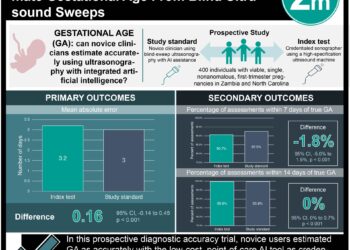Ultrasound, flow reserve guided coronary interventions provide minimal benefit
1. There was no difference in long term mortality amongst patients who underwent either fractional flow reserve (FFR)-guided percutaneous coronary intervention (PCI) or intravascular ultrasonography (IVUS)-guided PCI compared to angiography-guided PCI amongst patients undergoing elective or urgent PCI in the London, UK area.
2. Fewer total stents were implanted in those patients who underwent FFR-PCI compared to IVUS-PCI and angiography-PCI.
Evidence Rating Level: 2 (Good)
Study Rundown: Myocardial revascularization, particularly through catheters, is one of the most common procedures performed. Improvements in technology have allowed physicians to visualize the vessels via IVUS and measure pressures around stenotic lesions by measuring FFR both of which presumably aid in optimal stent deployment. This study, which followed a cohort of patients in the London, UK area who underwent elective or urgent PCI, did not find any difference in long term mortality amongst patients who underwent either FFR-PCI or IVUS-PCI compared to routine angiography-PCI. However, those patients who underwent FFR-PCI did have fewer total stent implantations compared to those who underwent IVUS-PCI and angiography-PCI. There were no other major differences in outcomes between the three groups of patients.
The major strength of the study was the size of the study population. Although the study did take place in the England, the results should be applicable to the American population as well. Since the groups using FFR-PCI and IVUS-PCI were small compared to the angiography-PCI, it is possible the lack of observed survival benefit may be related to sample size. Also, the mean follow up period of 3.3 years may not have been long enough to identify a survival benefit. Much of the decision making in terms of anticoagulation and the manner in which the different procedures were performed were left to the discretion of the individual providers, which may have interfered with the results.
Click to read the study in JAMA Internal Medicine
Relevant Reading: Long-term outcomes of fractional flow reserve-guided vs. angiography-guided percutaneous coronary intervention in contemporary practice
In-Depth [prospective cohort]: The study population was derived from the Pan-London database from January 1, 2004 to July 31, 2011. Of the 41,688 patients who underwent elective or urgent PCI, 2,767 (6.6%) patients underwent FFR-guided PCI, 1,831 (4.4%) underwent IVUS-guided PCI, and 37,090 (89%) underwent angiography-guided PCI. The patients were followed for a median of 3.3 yrs.
The adjusted mortality did not differ between FFR-guided PCI and angiography-guided PCI (HR, 0.88; 95% CI, 0.67-1.16; P=0.37). There was a higher adjusted mortality risk for IVUS-guided PCI compared to angiography-guided PCI (HR, 1.39; 95% CI, 1.09-1.78; P=0.009). The mean number of implanted stents was lower in the FFR group (1.1, SD 1.2) compared to the IVUS group (1.6, SD 1.3) and angiography group (1.7, SD 1.1). The complications amongst the three groups were low and did not differ significantly.
More from this author: Resveratrol levels not linked with decreased mortality (InCHIANTI Trial), Children’s exposure to violence and delinquency likely declined in past decade, Neonatal screening may be effective for salt wasting congenital adrenal hyperplasia, Increased hospitalist workload associated with decreased efficiency, COPD associated with increased risk for nonamnestic-mild cognitive impairment
Image: CC/Wiki
©2012-2014 2minutemedicine.com. All rights reserved. No works may be reproduced without expressed written consent from 2minutemedicine.com. Disclaimer: We present factual information directly from peer reviewed medical journals. No post should be construed as medical advice and is not intended as such by the authors, editors, staff or by 2minutemedicine.com. PLEASE SEE A HEALTHCARE PROVIDER IN YOUR AREA IF YOU SEEK MEDICAL ADVICE OF ANY SORT.







